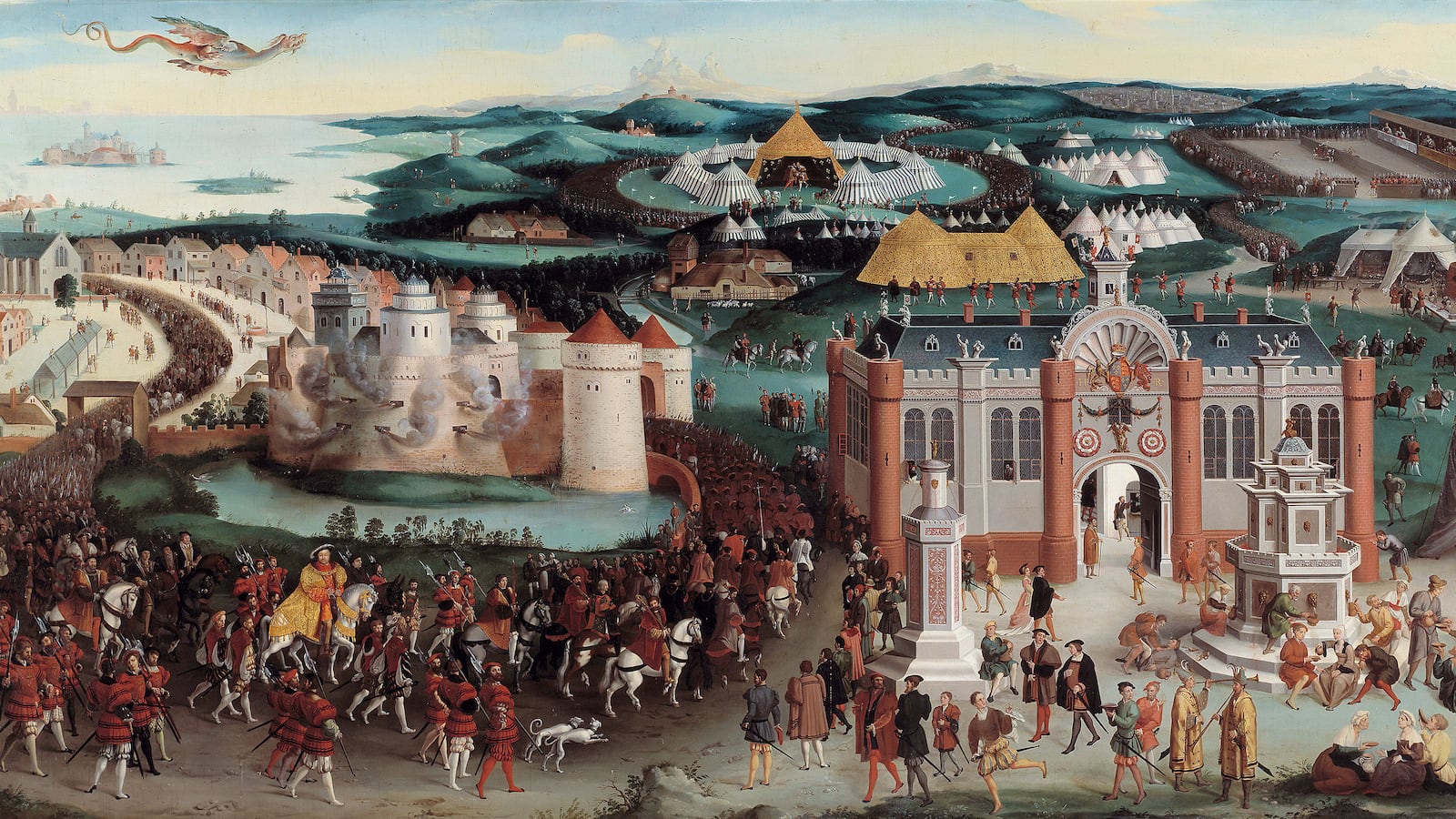On the evening of June 7, 1520, a crowd gathered in a field outside of Calais, which was then under the rule of England. One can imagine the finery of the noble onlookers, the gossip they exchanged, the bated breaths as they awaited the arrival of the two guests of honor—the kings of France and England.
By this time, the two countries had centuries of animosity beneath their glittering crowns, but an attempt was being made to change all that. This gathering that would become known as the Field of the Cloth of Gold was arranged as an 18-day celebration to solidify a new era of peace. Thousands of workers had toiled for months to erect massive gilded tent cities to house each of the royal delegations and the events—feasts, tournaments, and other revelry—that they would host.
Against the backdrop of booming cannons, the two mounted men appeared on either side of the field—King Henry VIII of England and King Francis I of France.
“As they gathered speed, both men raised their right hands as if about to draw their swords to attack. Instead, each reached for his feathered hat and doffed it as their cantering horses closed rapidly together,” writes historian Glenn Richardson in The Field of Cloth of Gold. The cousins dismounted, hugged one another, and kicked off the festivities.
The Field of the Cloth of Gold was an event unlike any other Europe had seen. It was an expression of newfound peace, a peacocking of cousins both trying to assert their royal dominance, and a weeks-long Renaissance rager for the socialites of the day.
“I can’t wait for the summit. It will change the world forever… Nothing will ever be the same, Your Eminence. You and I will be immortal,” Jonathan Rhys Meyers as King Henry VIII tells Cardinal Wolsey in the Showtime series The Tudors as they make preparations for the gathering.
But Rhys Meyers’s Henry VIII was wildly mistaken. While the events of the summit would go down in history, the era of amity it heralded was short-lived. In the days after the royal delegations left the field, the lavish campground was disassembled leaving behind only a new name—Val d’Or (“Valley of Gold”)—where the lavish campground had once stood. Two short years later, the precarious peace between the nations had also crumbled.
As many a period drama has taught us, the history of Europe is a real life game of thrones in which monarchs who often shared a familial relationship, however distant, jostled to prove their dominance. The affairs leading up to this historic meeting in the summer of 1520 were no different.
In the early 16th century, tensions were beginning to heat up once again between the major powers of Europe, particularly France’s King Francis and the Holy Roman Emperor Charles V, who was ruler of the Hapsburg realm. In an effort to stymie war, all major European powers signed the Treaty of London in 1518, vowing “that none of the signatories should attack one another and if they did the others would come to their aid.”
But signing kings’ names with a flourish wasn’t a grand enough gesture to mark this alliance, particularly between France and England. Instead, the two countries decided, there should be a special event held to underscore the importance of this new era in the relationship between the two rival nations.
History is divided on the true intentions of the organizers behind the Field of the Cloth of Gold. Many consider it a “splendid failure,” one that was arranged and attended mostly so that each king could show off and best his opponent in military might, riches, and power, or at least the appearance of such. With these impure intentions, the argument goes, it was no surprise that peace was fleeting.
It is true that both kings were deliberately putting on a show in the field-turned-global stage. As Noah Charney writes in Museum of Lost Art, the Field of the Cloth of Gold was “a contest of wealth and power and codpiece size in the guise of a tournament.”
But Richardson contends that their diplomatic intentions were honest, if maybe a bit far-fetched. Beyond the dreams of a historic alliance between England and France, “the event gave physical expression, as it were, to genuine hopes of peace between many other ‘ancient enemies’ among European rulers at a moment of crisis and profound change across the Continent.”
Whether the meeting was just an excuse to indulge in a little grandstanding or a true show of diplomacy matters little when it came to enjoying the grand display and party that materialized.
As of February 1520, each country was already in full planning mode. The logistics required to move two royal courts in all their grandeur to a field in the middle of nowhere was no small feat, especially when each side planned to attend with around 6,000 of their closest confidants, noblemen, and servants. (The number was agreed to ahead of time to prevent any noticeable imbalance.)
By May, French preparations were underway in the town of Tours where nearly 300 workers were engaged in making 300-400 tents for their delegation. Richardson writes that the archbishop’s palace would have been “lit day and night by torches” as hundreds of meters of cloth were delivered that, according to an inventory, included “cloth of gold, cloth of silver, damask, silk, satin, velvet and velour mostly of blue, violent, and crimson.” In addition to decking the tents out in the colors of the French king, they were also decorated with ample fleurs-de-lis.
Details of the French king’s personal accommodations have been lost, though it is known they included at least a tented pavilion and a banquet hall in addition to a townhouse he built nearby. According to The Guardian, one of the French tents was even taller than the White Tower in London, which was the tallest building in that city at the time.
But vertical prowess aside, in the grand scheme of competition, it was widely known that King Henry VIII won the housing wars with what was “acknowledged as the architectural masterpiece of the event.”
The English built a massive pavilion for their monarch to live and reign in while he was installed in the Calais field. The structure sat on a platform of brick, but the walls and roof were made of canvas designed in a trompe l’oeil effect that made them appear solid. They were amply draped in the notorious “cloths of gold.”
The temporary palace was made up of a series of connected tents that provided different rooms for sleeping, entertaining. living, and praying. There were windows made of glass, sculptures on the facade, and only the richest of furnishings and décor.
The English palace also featured two fountains out front, one that dispensed beer and the other wine, from which attendees could freely drink. This act of generosity no doubt contributed to the lush air of the festivities…and the scene that led one artist documenting the event to paint attendees passed out or getting sick nearby.
Their were tournaments of jousting, archery, and other games; there was a spontaneous wrestling match between the two kings after a bout of drinking (Francis easily defeated Henry); there were outfits for every occasion, and plenty song and dance.
The 12,000 people in residence in the Val d’Or had to be fed over the 18 days, a tough prospect when all provisions had to be carted in for the event.
According to Richardson, there were 3,406 sheep and lambs, 842 veal calves, 373 oxen, and 69 pigs transported to the area and served up on platters. Henry ordered in dozen after dozen quail. Beer was free-flowing for all attendees, while supplies of wine were mostly reserved for the nobility.
In addition to the general gluttony indulged at the Field of Cloth of Gold, there were also three banquets of epic proportions. Each course at each of the feasts allegedly consisted of 50 dishes. “The range, amount and expense of food on these occasions was astounding, even by royal standards,” Richardson writes.
No expense was spared in the outfitting of the kings and other aristocratic attendees, in the accommodations provided for each party and their décor, and in the food and other provisions supplied for the events. The scene was glorious… and fleeting.
As hangovers surely set in and the amount of gold expended surely began to be felt and fretted about, the delegations drifted back to their home-bases while the temporary city made of those famous cloths of gold slowly disappeared.
The illusion of peace and prosperity and political might that was created in a formerly nondescript field in an area of England that would eventually become a part of France slowly floated away and into the history books.
The historic event was as evanescent as the peace it celebrated. Not even two years after the distant cousins embraced each other at a Renaissance festival for the ages, they were meeting each other again on the battlefield.






